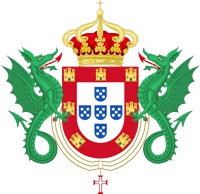| pictures of coin |
coin notes, font arial |
history notes, default font |

Peter II, 4000 Reis 1695
NGC AU Details
(Heritage Auctions, the Pernambucana Collection)
May 7th, 2021 lot# 30205 |
This is Portuguese Brazil's 1st gold coin. This subvariety was issued only in 1695, the obverse being changed slightly for 1696 - 1697 or 98 to make it look less crude. Compare with the 1696 below. At this time NGC lists
3 specimens, this one being the nicest. Until 1724, this was Brazil's largest denomination coin.
|
Brazil's first standard or true coin mint was opened in the city of Salvador, Province of Bahia in 1694. There was no mint mark, the mint was intended to meet local demand for currency and then move to wherever there was demand. Basically a moving mint. Subsequently it moved to Rio de Janeiro in 1698.
Brazilian mintmarks are named after the Province (today = State) where the coin was struck rather than the city. To add to the confusion frequently the provincial capital cities had the same name (but not always) as the Province. Thus "B" for Bahia, the Province, with it's main city of Salvador; Rio de Janeiro the capital of the State of Rio de Janeiro; and the same for the city of Sao Paulo in the state of the same name.
|

Peter II, 4000 Reis 1696
uncirculated but with 3
small scratches in shield side (rev)
(purchased from Ramiro Matos, M3C Numismatica,
Salvador, Bahia, Brazil) |
This is one of the the earliest Brazilian regular issue gold coins; actually the 2nd year issued. Brazil first started issuing gold coins in 1695, which was a one year type. This type of coin was struck from 1696 to 1698. The piece is uncirculated however has 3 small scratches underneath 3 of the 7 devices in the outer shield. They are very hard to discern. While I normally do not buy damaged coins, all of the 17th century Brazilian gold I've encountered had some sort of damage.
|
--
|
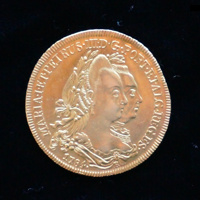
6400 Reis 1774 R, uncirculated
Rio de Janeiro mint
this denomination was also known as a "Peca" or "half-Joe"
(Sociedade Numismatica do Brazilera Auction, ) (photo by me)
|
Listed weight is 14.34g, fineness is .9166 (.4228oz.AGW). This denomination is known as a Peca. Also called (possibly in the US Colonies) a "half - Joe". It is substantially heavier than a Spanish Colonial or Latin American 4 escudos gold which was 13.54 g but had declined to only .875 finess.
Brazilian gold was issued in large quantities during this era and probably was the circulating gold in the early USA, as early US gold was barely struck and didn't circulate to any large extent.
|
Maria became queen in 1777 and reigned until 1815, but from 1792 on she suffered from dementia after her eldest son died. Her surviving soon, son, John became regent in 1799 and ruled in her name.
|

6400 Reis 1795, uncirculated
Rio de Janeiro mint
this denomination was also known as a "Peca" or "half-Joe"
(Sedwick Auctions, Winter Park,FL) (photo by Augi Garcia) |
|
Maria was extremely religious and conservative and curtailed
all attempts at modernization in Portugal. Lisbon was said to be the most backwards European capital at the time.
|

Joao (John) VI 6400 Reis 1811
uncirculated Rio de Janeiro mint
(SNB Auctions, Sao Paulo, Brazil) (photo pending) |
|
Joao VI moved the family and virtually the entire Portuguese Court to Brazil
to escape Napoleon Bonaparte.
An estimated 10,000 to 15,000 people* left Lisbon, Portugal just ahead of Napoleon's advancing army in November 1807, arriving in Brazil at the end of January 1808. They were escorted by the British fleet which had complete control of the seas at the time.
This was the first time in history that a European monarch ever visited his American colonies. Joao (John) & the court stayed for 13 years, until April 1821 and greatly changed Brazil.
|

Joao (John) VI 6400 Reis 1813
uncirculated Rio de Janeiro mint
(SNB Auctions, Sao Paulo, Brazil) (photo pending) |
|
|

Dom John VI
4000 Reis 1812 (gold)
uncirculated
(Gaston Beluscio, Buenos Aires, Argentina) |
wt= 7.207g |
|
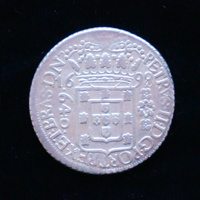
Peter II
640 Reis 1699 9 over 8
decent condition
(SNB Auction, S.P.) |
The 640 Reis
|
These were Brazil's first true circulating silver
crowns. Silver fractions of 320, 160, 80, and 20 were made. Copper pieces were also made of 80 reis down through 5 reis. The 640 reis was 1st stuck in 1695 and early dates are relatively common. They
were produced to supply silver coins to the local towns. This coin was known as 2 patacas, a pataca being equal to 320 reis.
Silver fineness was .9166, listed wt = 19.3g.
|
The 960 Reis
The 960's were made to overstrike silver crowns circulating in South America. As such these coins were much larger than the 640 reis so a new denomination, the 960 Reis, was coined.
These were 3 pataca pieces. They were also struck to provide an immediate profit to the Portuguese Crown which badly needed money.
Dates from 1810 to 1819 are common and were frequently overstruck on Spanish colonial and less frequently on Republican Latin American crowns. They also were frequently
overstruck on Spanish mainland silver 5 Peseta coins, as well as occasionally on old European thalers and US Bust dollars.
In 1808 the Emperor of Portugal & Brazil had Spanish Colonial silver 8 reales, 27.0674 grams, .9027 fine, valued at 750 - 800 reis, counter-stamped raising their value to 960 reis.
This generated a profit of 160 - 210 reis/coin (less stamping costs). Soon (1810) the entire coin was overstruck, possibly for the reason of making it harder to duplicate as
Spanish Colonial 8 reales were the common trade coin of the world at the time.
This practice was continued with the 8 reales of the new Latin American Republics after
their independence from Spain. It appears that an entire generation of early Latin America crowns were consumed as blanks for the 960 reis.
|

1809 960 Reis
bronze Pattern ,uncirculated NGC-64
(Heritage Auctions, Chicago Intl Coin Show,
August 13, 2015, lot 32138)
|
Here is also a blog about the 1st Pattern issues struck in 1809. The 1809 Patterns
Here is a good website just dedicated to the 960's:
sorry, it"s goneblog.960coins.com/2012/07/brief-intro-to-960-reis.html |
|
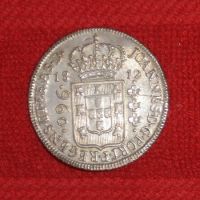
960 Reis, 1812-B
Province of Bahia
uncirculated
Alex Siegel, Houston, TX |
This is the 1st type of 960 reis. Obverse: Portuguese coat of arms with date & denomination.
Reverse: The Armillary Sphere over a Cross with the band of the Zodiac. |
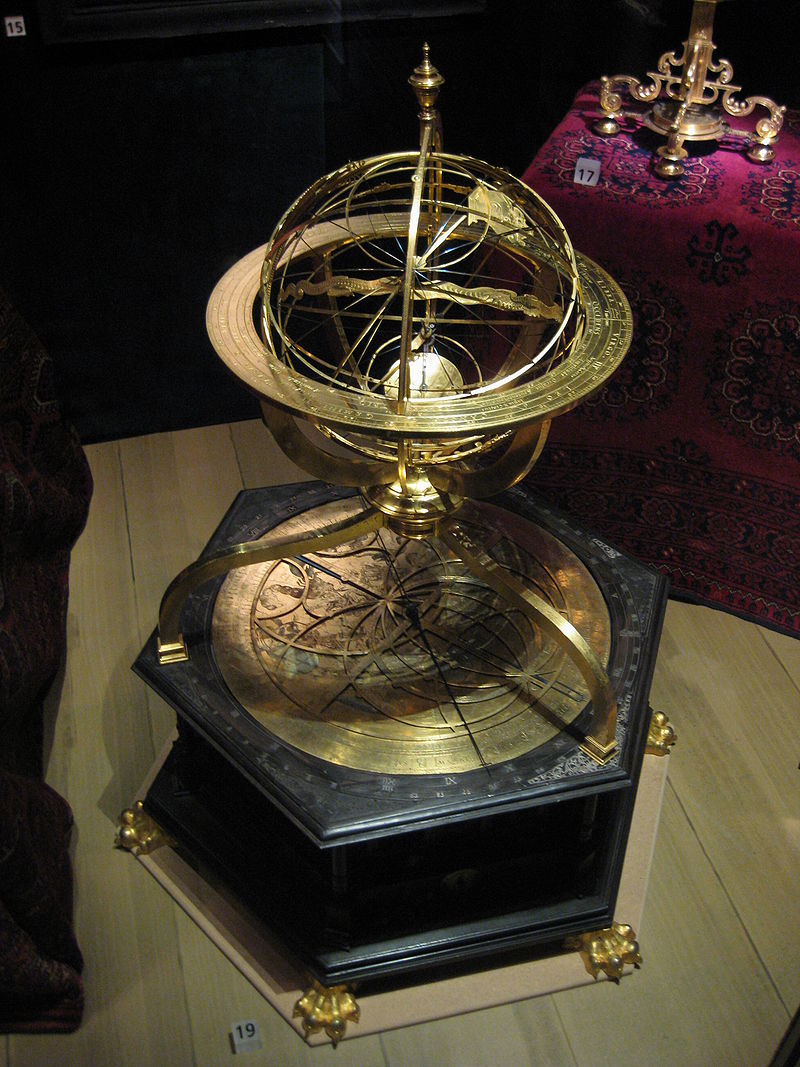
A model Armillary Sphere made in 1585.
|
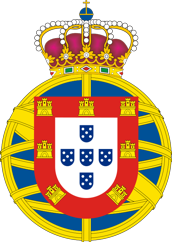 |
Brazil under the United Kingdom of Portugal, Brazil and the Algarves
This was the period from 1816 - 1822. |
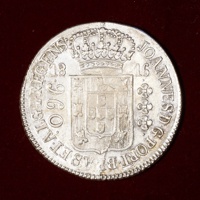
960 Reis 1816 Rio mint
Special Series
SNB Auction, Sao Paulo, Brazil
XXI Congresso, Dez, 2017 Lote# 268 |
The Special Series was minted exclusively in 1816 to commemorate the raising
in the status of Brazil to Co-Equal Partner in the Empire.
The Legend (obv)was changed from:
JOHANNES.D.G.PORT.P.REGENS.ET.BRAS.D.
to
JOHANNES.D.G.PORT.BRAS.ET.ALG.P.REGENS. |
Most of the 960's struck in 1816 were not the special series. These are a little difficult to
find in any grade and to my knowledge an unc one has never been certified. |
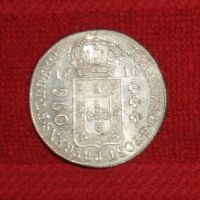
960 Reis, 1816-Rio mint
uncirculated, normal type
struck over a Potosi 1808 PJ 8R
(Alex Siegel)
|
|
|

960 Reis 1819 Rio
uncirculated
struck over Peru 8R, Km117
Alex Siegel |
As you can see the design was changed in 1818. On the obv was now a wreath with
coffee beans and the shield was placed over the Armillary Sphere for a combined image. |
|
